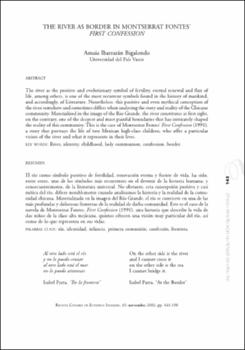The River as Border in Montserrat Fontes' First Confession
Fecha
2002Resumen
El río como símbolo positivo de fertilidad, renovación eterna y fuente de vida, ha sido,
entre otros, uno de los símbolos más recurrentes en el devenir de la historia humana, y
consecuentemente, de la literatura universal. No obstante, esta concepción positiva y casi
mítica del río, difiere notablemente cuando analizamos la historia y la realidad de la comunidad
chicana. Materializado en la imagen del Río Grande, el río se convierte en una de las
más profundas y dolorosas fronteras de la realidad de dicha comunidad. Este es el caso de la
novela de Montserrat Fontes, First Confession (1991), una historia que describe la vida de
dos niños de la clase alta mejicana, quienes ofrecen una visión muy particular del río, así
como de lo que representa en sus vidas. The river as the positive and evolutionary symbol of fertility, eternal renewal and flux of
life, among others, is one of the most recurrent symbols found in the history of mankind,
and accordingly, of Literature. Nonetheless, this positive and even mythical conception of
the river somehow and sometimes differs when analysing the story and reality of the Chicano
community. Materialized in the image of the Rio Grande, the river constitutes at first sight,
on the contrary, one of the deepest and most painful boundaries that has intricately shaped
the reality of this community. This is the case of Montserrat Fontes’ First Confession (1991),
a story that portrays the life of two Mexican high-class children, who offer a particular
vision of the river and what it represents in their lives.





